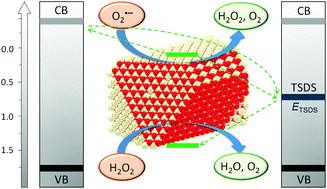Simultaneous enzyme mimicking and chemical reduction mechanisms for nanoceria as a bio-antioxidant: a catalytic model bridging computations and experiments for nanozymes†
Abstract
The bio-antioxidant ability of nanoceria has been mainly ascribed to its ability to mimic superoxide dismutase (SOD) and catalase (CAT), and its mechanisms are thought to be analogous to those of the natural enzymes. Accordingly, nanoceria has been called a nanozyme, a nanomaterial mimicking enzymes. Because they overlook the real structural features of nanoceria, these hypothetical mechanisms cannot explain the important antioxidant experiments of nanoceria and have little predictive power. We hereby study the O2˙− and H2O2 scavenging mechanisms of nanoceria using first principles calculations, taking into account the role of oxygen vacancies that are practically abundant in nanoceria. The results reveal atomistic-level mechanisms responsible for the SOD and CAT mimetic activities of nanoceria. The newly created surface defect states in the electronic band structures of the shortly-lived intermediate species, called transient surface defect states (TSDSs), play critical roles in the enzyme mimetic catalysis and can serve as the bridge between computations and experiments at the atomistic level. The energy levels of TSDSs, which depend on the concentration and distribution of oxygen vacancies, determine whether the nanoceria is eligible for the catalysis. Besides the known enzyme mimicking mechanisms, the non-catalytic chemical reduction mechanisms are also responsible for the scavenging of O2˙− and H2O2, in which nanoceria serves as a reducing agent rather than a catalyst. The chemical reduction pathways poison the active sites of nanoceria which serve to mimic SOD and thus deteriorate its SOD mimetic activity. The results provide guidance for the engineering of nanoceria for bio-antioxidant applications. In particular, the proposed catalytic model can be generalized for the screening and design of high-performance nanozymes based on semiconductor nanomaterials.

- This article is part of the themed collections: Research selection from the NCNST and 2019 Nanoscale HOT Article Collection


 Please wait while we load your content...
Please wait while we load your content...